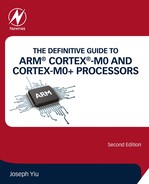21.8. Generic Assembly Code for Interrupt Control
For C/C++ language users, a function library for interrupt control is already provided in the CMSIS. The CMSIS-CORE APIs are included in the device driver libraries from all major microcontroller vendors and is openly accessible. More details of the CMSIS are covered in Chapter 3—Introduction to Embedded Software Development (Section 3.5—Cortex® Microcontroller Software Interface Standard).
For users programming the Cortex-M0 or Cortex-M0+ processor using assembly language, it could be handy to have a set of generic functions for handling interrupt control with the Nested Vectored Interrupt Controller (NVIC).
21.8.1. Enable and Disable Interrupts
The enable and disable of interrupts is quite simple. The following functions “nvic_set_enable” and “nvic_clr_enable” require the interrupt number as input, which is stored in R0 before the function call.
To use the functions, just put the interrupt number in R0, and call the function. For example,
MOVS R0, #3 ; Enable Interrupt #3
BL nvic_set_enable
The FUNCTION and ENDFUNC keywords are used to identify start and end of a function in ARM® assembler (including Keil MDK-ARM). This is optional. The “ALIGN” keyword ensures correct alignment of the starting of the function.
21.8.2. Set and Clear Interrupt Pending Status
The assembly functions for setting and clear of interrupt pending status are very similar to the ones for enable and disable interrupts. The only changes are labels and NVIC register address values.
Note that sometimes clearing of pending status of an interrupt might not be enough to stop the interrupt from happening. If the interrupt source generates an interrupt request continuously (level output), then the pending status could remain high even if you try to clear it at the NVIC.
21.8.3. Setting Up Interrupt Priority Level
The assembly function to set up priority level for as interrupt is a bit more complex. First, it requires two input parameters: the interrupt number and the new priority level. Secondly, the priority level register address has to be calculated as there are up to eight priority registers. And finally, the function needs to perform a read-modify-write operation to the correct byte inside the 32-bit priority level register, as the priority level registers are word access only.
In most applications, however, you can use a much simpler code to set up priority levels of multiple interrupts in one go at the beginning of the program. For example, you can predefine the priority levels in a table of constant values, and then copy it to the NVIC priority level registers using a short instruction sequence:
..................Content has been hidden....................
You can't read the all page of ebook, please click here login for view all page.
